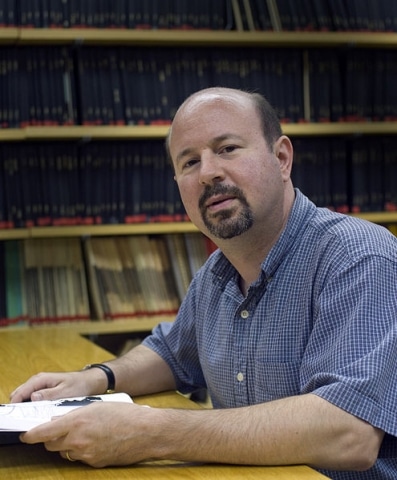In Part II of our intimate interview with Professor Michael Mann he tells of the exact moment he fully acknowledged humans were driving climate change – and how his conversion was thanks to the invention of the colour printer. Read Part I here. The interview forms part of our Epic History of climate denial.
Michael Mann, the scientist behind the climate change hockey stick graph, began his PhD at the Department of Geology and Geophysics at Yale University under the supervision of Professor Barry Saltzman.
He remembers Saltzman as an “old fashioned scientist” who remained deeply sceptical about the latest claims being made by climate scientists that the atmosphere had begun warming and the future was bleak.
Mann himself was weary of the news reports and some of the peer-reviewed literature at this time.
“You know, when I came into this field in the early 90s, the Intergovernmental Panel on Climate Change (IPCC) had not concluded that there was a discernible human influence on the climate. There was still a scientific debate about that.
“There was not a legitimate scientific debate about whether greenhouse gases would in warm the climate. That was established more than a century ago. But there was still some debate about the level of natural variability and the extent to which that greenhouse warming signal had emerged from the background of natural variability.”
Physicist Mindset
The scientist certainly did not consider himself any kind of political radical or environmentalist. “I had the mindset of a physicist. I understand where some physicist climate change deniers are coming from.”
He added: “I still remember being sceptical about pretty much all claims. There’s a tendency for the physicist to think that they understand a problem at a level that experts in other fields can’t. I understand and appreciate where that comes from – because I was there.”
Mann was interested in Saltzman’s work with climate models: “But it wasn’t because, ‘hey, I’m an environmentalist and I want to save the world’. It was more: ‘hey, this problem is interesting and it also really matters’.”
As a graduate student, Mann was partly funded by the Electric Power Research Institute (EPRI) which is funded by the electric power industry – fossil fuel interests.
Fossil Fuel Funding
“I was once supported by the fossil fuel industry in a very real sense. And my guess is that they funded Barry in part because he was a sceptic – but he was sceptic in the honest sense.”
Mann’s PhD examined the natural variation in climate to establish whether this might be at least a partial cause of recent global warming. “So I went into climate research more from the standpoint of somebody who was more on the sceptical side. Some of my early work was actually celebrated by climate change deniers,” he explains.
But then something changed his mind.
Mann started doing research with Saltzman and another of the professor’s former students. This was Robert Oglesby, a postdoctoral researcher who is now with the University of Nebraska working on general circulation modelling (GCM).
Colour Maps
The scientists had privileged access to the very latest technology—including modelling software and even a colour printer.
“This was in the early days of computer printers. So to get a colour printout you had to get special paper, and you would go up to the third floor to the special colour printer, so there was a certain drama. Until you printed it out in colour on paper you couldn’t really appreciate the results.”
They printed out world maps which had been colour-coded to show the rise in temperatures for each of the decades, moving through light yellows for little change to reds for the occasional spot where there had been a significant rise.
These maps are now ubiquitous in climate research and reporting, but this was the first time Mann had produced or even seen one like this.
Discernible Influence
“We were just looking decade by decade where there’s been maps of temperatures: 1900, 1910s, 20s, 30s, all the way to the 70s. And if you compare the 70s map to the 1900s map, there isn’t much of a difference,” Mann remembers.
“But once you get to the 1980s, it’s like ‘bam!‘ The map turns bright yellow and red. It was in that moment that I actually think that all of us, including Barry I think, crossed over into weighing more on the side that there is a discernible human influence on climate. This is before the IPCC reached that conclusion in 1995 with the publication of the second assessment report.”
In a single moment, Mann abandoned his scepticism about the reality of human-caused climate change. As it happens, he would dedicate the rest of his working life to understanding the true scientific meaning and implications of those red smudges on an early colour printout.
There were three scientists in the room that day. No politicians, no ideologues, no closet Communists tampering with the ink cartridges.
Science-Led
Mann points out: “The important thing to understand there is that our views on this issue were led by the science we were doing, which is the way it should be. The science that we were doing was not influenced by our views on the climate change issue.”
The colour maps formed part of Mann’s first climate change publication, with colleagues, in a peer-reviewed paper. He then set about trying to place modern climate change in a larger context.
What he found, and what he wrote, would throw him headfirst into a sometimes vicious and soul-destroying battle with the climate sceptics who had previously celebrated his work.
Next time, we look at how the dynamic Professor Bob Watson became chairman of the IPCC in 1997 amidst a groundswell of political activity.
Subscribe to our newsletter
Stay up to date with DeSmog news and alerts







